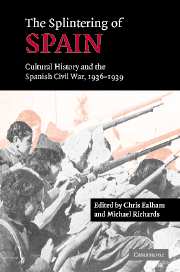Book contents
- Frontmatter
- Contents
- List of illustrations
- List of maps
- List of contributors
- Preface
- List of abbreviations
- Chronology
- Maps showing the division of Spain, 1936-1939
- 1 History, memory and the Spanish civil war: recent perspectives
- Part I Overviews: violence, nationalism and religion
- Part II Republican political and cultural projects
- 5 Catalan populism in the Spanish civil war
- 6 The myth of the maddened crowd: class, culture and space in the revolutionary urbanist project in Barcelona, 1936–1937
- 7 The culture of empowerment in Gijón, 1936–1937
- Part III Identities on the Francoist side
- Notes
- Index
7 - The culture of empowerment in Gijón, 1936–1937
Published online by Cambridge University Press: 28 July 2009
- Frontmatter
- Contents
- List of illustrations
- List of maps
- List of contributors
- Preface
- List of abbreviations
- Chronology
- Maps showing the division of Spain, 1936-1939
- 1 History, memory and the Spanish civil war: recent perspectives
- Part I Overviews: violence, nationalism and religion
- Part II Republican political and cultural projects
- 5 Catalan populism in the Spanish civil war
- 6 The myth of the maddened crowd: class, culture and space in the revolutionary urbanist project in Barcelona, 1936–1937
- 7 The culture of empowerment in Gijón, 1936–1937
- Part III Identities on the Francoist side
- Notes
- Index
Summary
The civil war began in Gijón as it did in many other ‘red’ cities and towns across Spain. When the military leaders declared their support for the rebellion, supporters of the Republic poured into the streets, brought out by factory and port sirens and the urgent calls by trade union leaders to meet at the Casa del Pueblo to plan the defence of their city. Those who gathered, mainly working-class men of the union movements, elected a defence committee which proceeded to procure arms for ‘the people’ and, with the support of loyal police, to engage the rebel soldiers in battle. By the end of the day, the rebels had to retreat to their barracks, from where they continued their struggle, aided by warships shelling from the harbour. The rebel hold-outs were finally defeated on 21 August 1936, leaving Gijón and much of eastern and central Asturias (with the exception of the capital city, Oviedo) in republican hands until the nationalists took the city in October 1937.
However, the Republic that was saved from the rebels had itself been transformed, as political power shifted from the republican parties to the trade unions. As formal institutions collapsed, at both the national and local levels, the vacuum of power was filled by whichever local groups had the best capacity to mobilise and organise masses of people – especially militiamen – in a crisis situation.
- Type
- Chapter
- Information
- The Splintering of SpainCultural History and the Spanish Civil War, 1936–1939, pp. 133 - 156Publisher: Cambridge University PressPrint publication year: 2005
- 1
- Cited by



